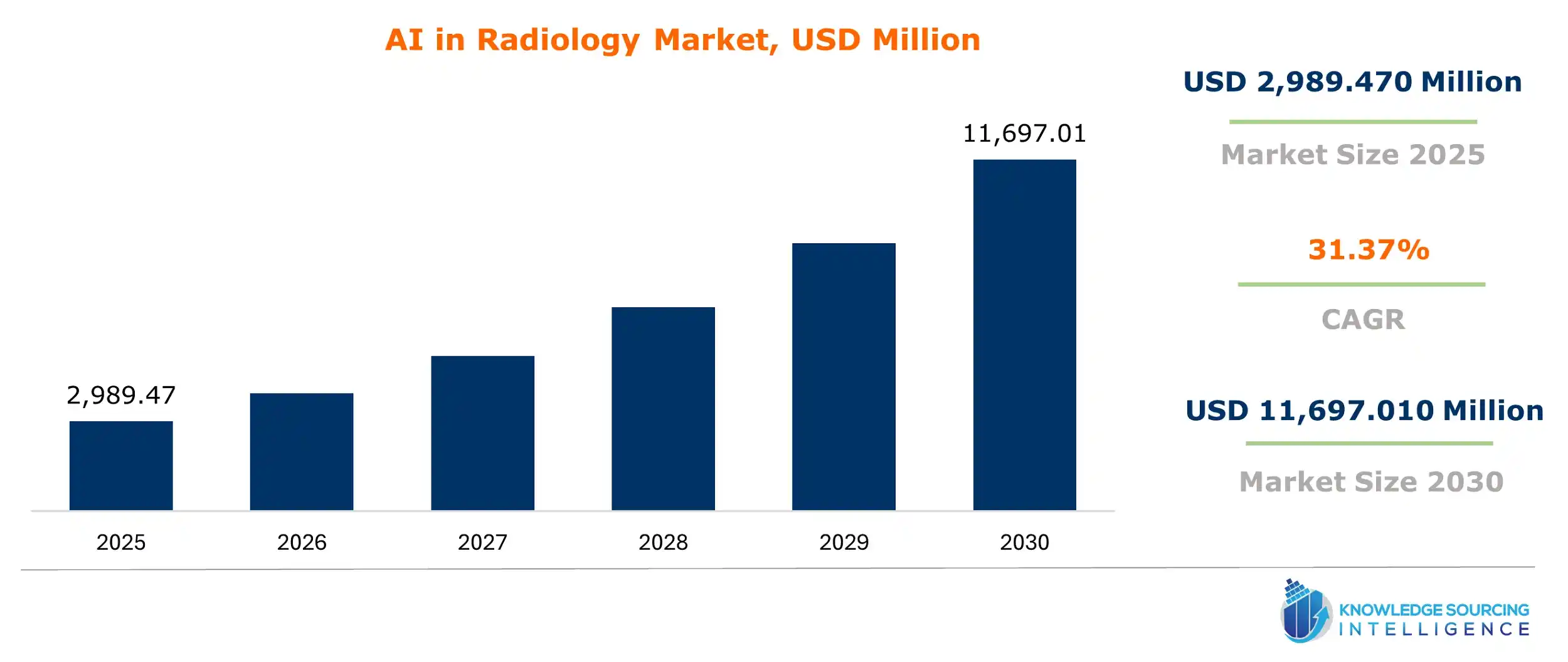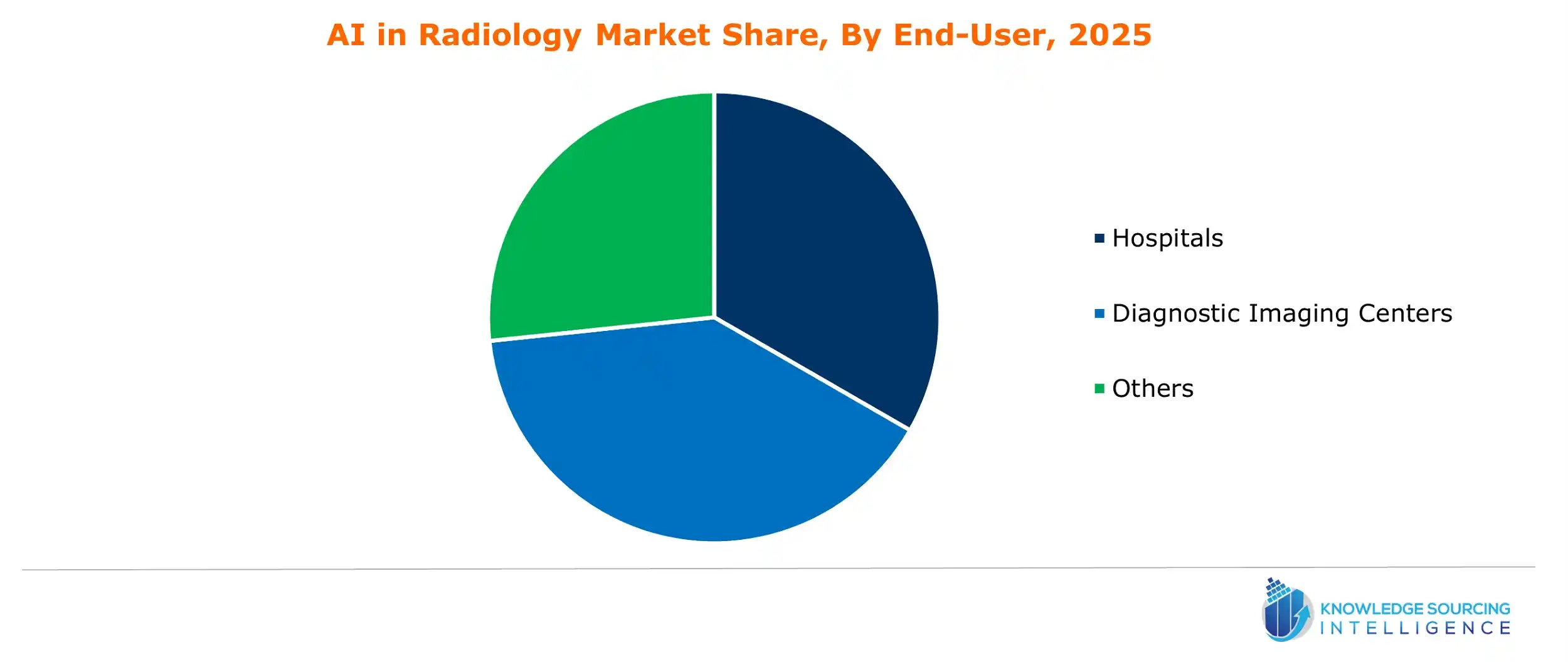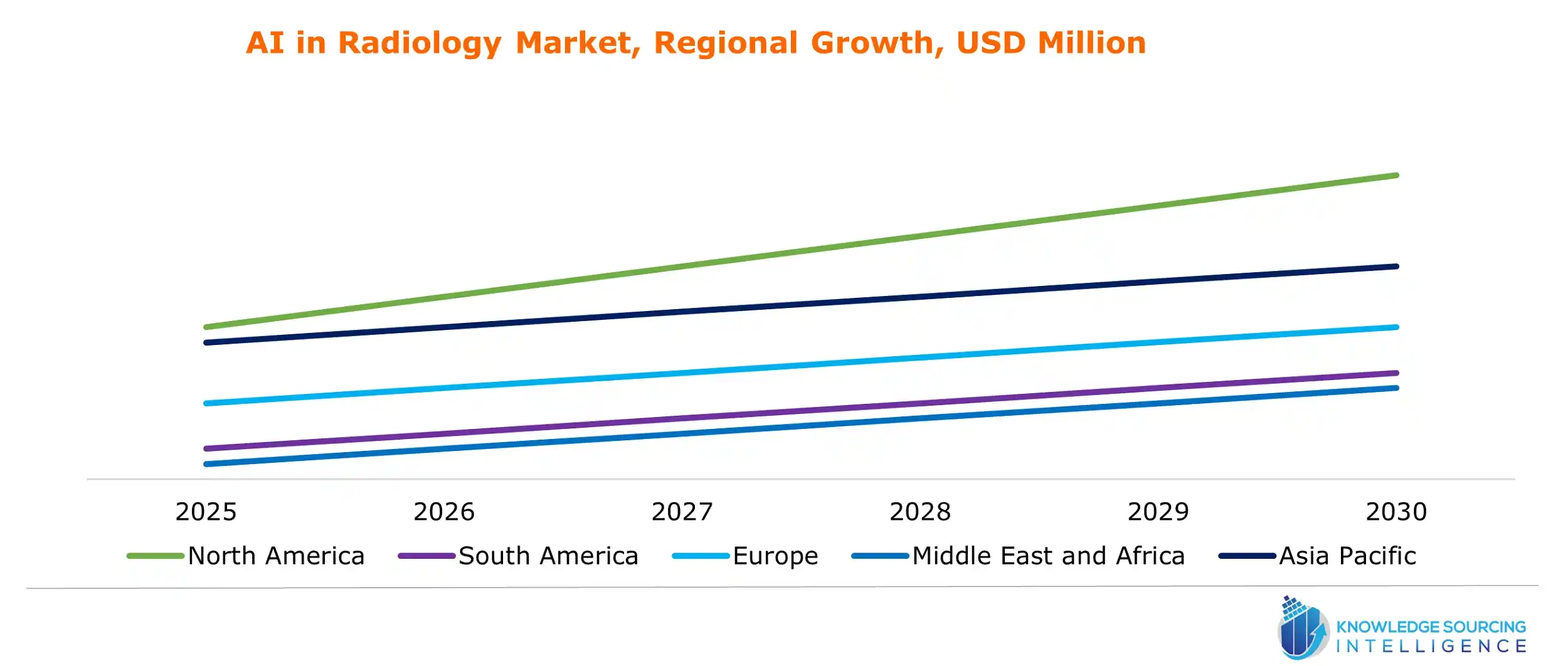Artificial Intelligence (AI) in Radiology Market Size, Share, Opportunities, And Trends By Component (Software, Hardware), By Diagnostic Type (Radiology, Pathology, Cardiology, Oncology, Neurology, Others), By Application (Disease Detection, Image Analysis, Risk Assessment, Predictive Analysis, Others), By End-User (Hospitals And Clinics, Diagnostic Laboratories, Research Institutions, Others), And By Geography - Forecasts From 2025 To 2030
Description
AI in Radiology Market Size:
The AI In The Radiology Market is projected to grow at a CAGR of 31.37% during the forecast period, reaching a total market size of US$11,697.010 million by 2030, up from US$2,989.470 million in 2025.
AI in Radiology Market Highlights:
- Advanced AI Algorithms: Deep learning enhances precision in radiographic image analysis.
- Neurological Demand: AI improves brain tumor detection and treatment outcome predictions.
- Asia Pacific Growth: Rising healthcare investments drive AI radiology market expansion.
- Industry Investments: Major firms and startups boost AI integration in radiology.

Deep learning algorithms in artificial intelligence (AI) have been perfected in vision-based applications. The medical image analysis domain is expanding rapidly with the realization of variational autoencoders and convolutional neural network techniques. Traditional qualitative assessments for radiographic qualities differ since the measure is easy to perform. Moreover, AI techniques are more advanced at analyzing mechanically difficult information patterns in imaging information. For instance, in radiology, AI algorithms could be designed to measure specific radiographic characteristics, such as the 3D shape of a tumor, every pixel's texture, and pixel intensity within the tumor.
X-ray radiography is when licensed medical doctors study clinical photos and kit a statement or identify and single out diseases that allow disorders to be detected, identified, and monitored. That assessment requires a lot of expertise and experience, which is sometimes susceptible to opinion. In contrast to this qualitative, subjective evaluation, AI is extremely good at identifying subtle patterns in imaging data while automatically providing an objective numerical analysis. Implementing AI to support and assist mammogram physicians can result in more precise and reproducible radiological assessments. This application is opening the door to further development into AI in the radiology market in years or decades to come.
AI in Radiology Market Growth Drivers:
- Growing applications and ventures by major medical firms to incorporate AI in healthcare have been major drivers of AI in the radiology market.
AI in medical image use, such as processing or radiographing, and interpreting, is one of the leading frontiers for health innovation. Software is a key component of various medical devices, and with the advancements in technology in healthcare sectors, program integration with AI-like machine learning (ML) tech programs and systems has grown. One of the greatest benefits of machine learning is its ability to parse insights from vast amounts of data, making it especially game-changing in an industry where copious amounts of data are generated daily.
In addition, these systems, when applied to radiology data such as traditional radiography, CT, MRI, and PET scans, as well as entire radiology reports, enable the detection of extremely complex patterns. These patterns are automatically recognized by the machine learning system and its software, thereby assisting doctors in making more informed decisions.
Furthermore, several start-ups have received government support to promote AI for radiology purposes with safer measures. For instance, in October 2023, the President of the United States issued an Executive Order to create a coordinated Federal strategy to ensure security, safety, and public acceptance of AI. In order, the president pinpointed how AI promised to help address dire needs and moderately grow the economy and security. Among other things, it requires a concerted, society-wide response by the government, industry, academia, and civil society to lower the possible barriers of entry for non-expert individuals designing, synthesizing, acquiring, or using CBRN weapons.
- The increasing requirement from the neurological treatment sector is anticipated to drive AI in the radiology market.
Working off of volumetric tumor segmentation, AI can improve identification and detection across all brain tumors and other neurological cancers with superior accuracy and consistency. The system will also automatically identify brain tumors on MRI scans. These strategies can be extremely valuable in providing precise diagnoses and assessing the tumor response to treatment in a reproducible and unbiased manner. Another use case in this neurological treatment is the prediction of outcomes using AI, which can assist in utilizing the best strategy. Background: Machine learning has been used to predict survival among patients based on blood volume distribution data from MR imaging.
For instance, in February 2023, Avicenna, an AI platform for radiology screening, raised €7 million in a series A venture, bringing its capital base to €10 million. The stage employs image-trained deep learning to recognize and evaluate life-threatening ailments in radiology research facilities. It uses CT scan imaging to prioritize patients with symptoms before diagnosis. Avicenna.AI offers two variations: one for heart attack indications and chance, and another for brain damage and stroke chance. The platform assists radiologists in deciding if a patient's life is threatened.

AI in Radiology Market Geographical Outlook:
- The Asia Pacific region is expected to hold a substantial AI in radiology market share.
Asia Pacific is projected to hold substantial shares of AI in the radiology market owing to a rise in research spending and development in the medical and biotech industries. Moreover, the expected large number of patients in these areas will increase the demand for better cancer treatment infrastructure, propelling healthcare sector growth and aiding market development at a regional level. Asia Pacific has also seen investment in the healthcare sector, especially in emerging economies, to advance newer technologies.
The region's economies are increasingly focusing on creating a sound healthcare system for early patient diagnosis and treatment. In addition, various key companies are focusing on advancing their reach to Asia Pacific countries by building their facilities, leading to the regional market’s growth in the coming years. For instance, in May 2023, Annalise. AI, an AI-based radiology company that is a global leader in the field, established its first Indian center in Chennai. Through this strategic move, Annalise continues penetrating the world arena with its presence in established and emerging markets like Asia. This translates into a center that specializes in the research and commercialization of new products containing advanced imaging data coupled with computer science, which together result in complete AI solutions to support clinical decision-making.

AI in Radiology Market Key Developments:
- June 2022- Healthcare AI firm Annalise signed an exclusive agreement with Fujifilm Australia to distribute AI's decision support solutions for chest X-ray systems, both portable and stationary. One of the leading applications for chest X-rays is Annalise CXR Edge, whose AI algorithm can also analyze screening results and detect any suspected findings in less than 10 seconds.
List of Top AI in Radiology Companies:
- Microsoft Corporation
- Amazon Web Services Inc.
- IBM Corporation
- Rad AI
- Behold.ai
AI in Radiology Market Scope:
| Report Metric | Details |
| AI in Radiology Market Size in 2025 | US$2,989.470 million |
| AI in Radiology Market Size in 2030 | US$11,697.010 million |
| Growth Rate | CAGR of 31.37% |
| Study Period | 2020 to 2030 |
| Historical Data | 2020 to 2023 |
| Base Year | 2025 |
| Forecast Period | 2025 – 2030 |
| Forecast Unit (Value) | USD Million |
| Segmentation |
|
| Geographical Segmentation | North America, South America, Europe, Middle East and Africa, Asia Pacific |
| List of Major Companies in AI in Radiology Market |
|
| Customization Scope | Free report customization with purchase |
Artificial intelligence (AI) in radiology market is analyzed into the following segments:
- By Technology
- Computer-aided Detection
- Auto-segmentation of Organs
- Natural Language Processing
- Consultation
- Quantification and Kinetics
- Others
- By Application
- Mammography
- Chest Imaging
- Neurology
- Cardiovascular
- Others
- By End-User
- Hospitals
- Diagnostic Imaging Centers
- Others
- By Geography
- North America
- USA
- Canada
- Mexico
- South America
- Brazil
- Argentina
- Others
- Europe
- Germany
- France
- United Kingdom
- Spain
- Others
- Middle East and Africa
- Saudi Arabia
- UAE
- Israel
- Others
- Asia Pacific
- China
- Japan
- India
- South Korea
- Indonesia
- Taiwan
- Others
- North America
Our Best-Performing Industry Reports:
- AI In Clinical Settings Market
- AI In The Edtech Market
- Artificial Intelligence (AI) In Dermatology Diagnosis Market
Navigation
Frequently Asked Questions (FAQs)
The ai in radiology market is expected to reach a total market size of US$11,697.010 million by 2030.
AI in Radiology Market is valued at US$2,989.470 million in 2025.
The ai in radiology market is expected to grow at a CAGR of 31.37% during the forecast period.
The Asia Pacific region is anticipated to hold a significant share of the ai in radiology market.
Prominent key market players in the ai in radiology market include IMAGEN, Aidoc, Koninklijke Philips N.V., GE Healthcare, Siemens Healthcare GmbH, among others.
Table Of Contents
1. INTRODUCTION
1.1. Market Overview
1.2. Market Definition
1.3. Scope of the Study
1.4. Market Segmentation
1.5. Currency
1.6. Assumptions
1.7. Base and Forecast Years Timeline
1.8. Key benefits for the stakeholders
2. RESEARCH METHODOLOGY
2.1. Research Design
2.2. Research Process
3. EXECUTIVE SUMMARY
3.1. Key Findings
4. MARKET DYNAMICS
4.1. Market Drivers
4.2. Market Restraints
4.3. Porter’s Five Forces Analysis
4.3.1. Bargaining Power of Suppliers
4.3.2. Bargaining Power of Buyers
4.3.3. Threat of New Entrants
4.3.4. Threat of Substitutes
4.3.5. Competitive Rivalry in the Industry
4.4. Industry Value Chain Analysis
4.5. Analyst View
5. AI IN RADIOLOGY MARKET BY TECHNOLOGY
5.1. Introduction
5.2. Computer-aided Detection
5.3. Auto-segmentation of Organs
5.4. Natural Language Processing
5.5. Consultation
5.6. Quantification and Kinetics
5.7. Others
6. AI IN RADIOLOGY MARKET BY APPLICATION
6.1. Introduction
6.2. Mammography
6.3. Chest Imaging
6.4. Neurology
6.5. Cardiovascular
6.6. Others
7. AI IN RADIOLOGY MARKET BY END-USER
7.1. Introduction
7.2. Hospitals
7.3. Diagnostic Imaging Centers
7.4. Others
8. AI IN RADIOLOGY MARKET BY GEOGRAPHY
8.1. Introduction
8.2. North America
8.2.1. By Technology
8.2.2. By Application
8.2.3. By End-User
8.2.4. By Country
8.2.4.1. USA
8.2.4.2. Canada
8.2.4.3. Mexico
8.3. South America
8.3.1. By Technology
8.3.2. By Application
8.3.3. By End-User
8.3.4. By Country
8.3.4.1. Brazil
8.3.4.2. Argentina
8.3.4.3. Others
8.4. Europe
8.4.1. By Technology
8.4.2. By Application
8.4.3. By End-User
8.4.4. By Country
8.4.4.1. Germany
8.4.4.2. France
8.4.4.3. United Kingdom
8.4.4.4. Spain
8.4.4.5. Others
8.5. Middle East and Africa
8.5.1. By Technology
8.5.2. By Application
8.5.3. By End-User
8.5.4. By Country
8.5.4.1. Saudi Arabia
8.5.4.2. UAE
8.5.4.3. Israel
8.5.4.4. Others
8.6. Asia Pacific
8.6.1. By Technology
8.6.2. By Application
8.6.3. By End-User
8.6.4. By Country
8.6.4.1. China
8.6.4.2. Japan
8.6.4.3. India
8.6.4.4. South Korea
8.6.4.5. Taiwan
8.6.4.6. Indonesia
8.6.4.7. Others
9. COMPETITIVE ENVIRONMENT AND ANALYSIS
9.1. Major Players and Strategy Analysis
9.2. Market Share Analysis
9.3. Mergers, Acquisitions, Agreements, and Collaborations
9.4. Competitive Dashboard
10. COMPANY PROFILES
10.1. Microsoft Corporation
10.2. Amazon Web Services Inc.
10.3. IBM Corporation
10.4. Rad AI
10.5. Behold.ai
10.6. IMAGEN
10.7. Aidoc
10.8. Koninklijke Philips N.V.
10.9. GE Healthcare
10.10. Siemens Healthcare GmbH
Companies Profiled
Microsoft Corporation
Amazon Web Services Inc.
IBM Corporation
Rad AI
Behold.ai
IMAGEN
Koninklijke Philips N.V.
GE Healthcare
Siemens Healthcare GmbH
Related Reports
| Report Name | Published Month | Download Sample |
|---|---|---|
| Healthcare Artificial Intelligence Market Insights: Report 2030 | November 2025 | |
| AI in Medical Imaging Market Report: Size, Share, Forecast 2030 | July 2025 | |
| AI in Precision Medicine Market Report 2030: Industry Insights | November 2025 | |
| AI in Remote Postnatal Care Market Insights: Size, Report 2030 | November 2025 | |
| US Healthcare AI Market Report 2030: Industry Insights and Growth | November 2025 |